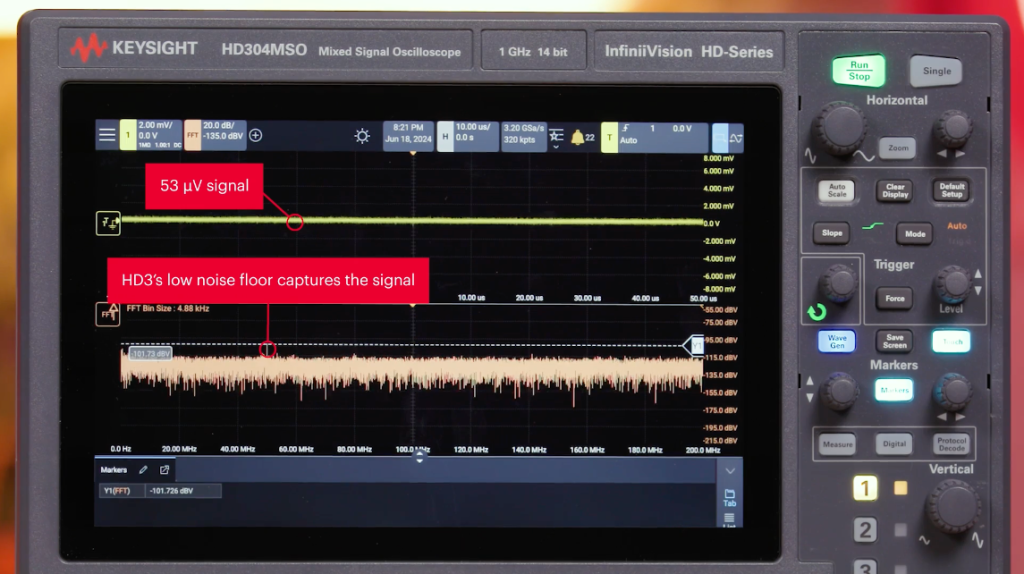It’s critical to recognize that not all oscilloscopes are made equal. Engineers need to opt for the highest ADC bit, combined with a low noise floor, to achieve the highest vertical accuracy. This combination ensures the oscilloscope accurately represents the signal, minimizing any distortion or noise that could affect the measurements. High vertical accuracy is essential for precise measurements, reducing errors, and saving time and resources. By investing in oscilloscopes with high vertical accuracy, engineers can trust their measurements, leading to more efficient debugging.
In the world of engineering, precision is paramount. Whether it’s performing quality assurance on cutting-edge electronics or debugging complex systems, the accuracy of measurements can make or break a project. This is where the concept of vertical accuracy in oscilloscopes becomes crucial, which refers to how closely the voltage readings match the actual voltage of the signal being measured. Achieving high vertical accuracy depends on two factors: the number of analog-to-digital converter (ADC) bits and the noise floor of the oscilloscope.
The Role of ADC Bits
The horizontal axis of an oscilloscope represents the time base (seconds per division or s/div), while the vertical axis shows the voltage (volts per division or V/div). Vertical accuracy is about how accurately the oscilloscope displays the voltage of the signal, which is vital for visual representation and precise measurements. The closer the voltage reading on the oscilloscope screen is to the actual signal voltage, the higher the vertical accuracy.
To achieve the optimal reading, engineers need oscilloscopes with the highest number of ADC bits and the lowest noise floor. Higher ADC bits provide more vertical resolution, leading to more precise signal visualization, while a lower noise floor minimizes the oscilloscope’s impact on the signal. This combination ensures the oscilloscope provides the most accurate representation of the signal, minimizing any distortion or noise that could affect the measurements.
“While a high number of ADC bits is essential for vertical accuracy, it is not the only factor. The noise floor of the oscilloscope also plays a critical role.”
Michelle Tate, Product Marketing Manager at Keysight Technologies
To look at this in more detail, an oscilloscope with an 8-bit ADC can encode an analog input into 256 unique levels of conversion (28 = 256). Each additional bit doubles the number of levels of conversion. Therefore, 9 bits provide 512 levels (29 = 512), 10 bits provide 1,024 levels (210 = 1,024), and so on.
Oscilloscopes with a 14-bit ADC can encode the analog input into 16,384 levels (214 = 16,384), which is 4x the resolution of an average 12-bit ADC oscilloscope and 64 times the resolution of an 8-bit ADC. This higher resolution allows the oscilloscope to capture finer details of the signal, providing a more accurate representation.
Now consider how this applies to an oscilloscope with a vertical setting of 100 mV per division and 8 vertical divisions. The oscilloscope’s full screen equals 800 mV (100 mV/div * 8 divisions). With an 8-bit ADC, the full screen (800 mV) is divided into 256 levels, resulting in a resolution of 3.125 mV per level. In comparison, a 14-bit ADC divides the same 800 mV into 16,384 levels, achieving a resolution of 48.8 µV per level. This significant increase in resolution allows engineers to detect and measure much smaller changes in the signal, as shown in Figure 1.

Figure 1. As the number of ADC bits increases, so does the number of levels of conversion. This results in a higher vertical resolution that enables engineers to measure much smaller changes in the signal.
The Importance of a Low Noise Floor
While a high number of ADC bits is essential for vertical accuracy, it is not the only factor. The noise floor of the oscilloscope also plays a critical role. This refers to the intrinsic noise generated by the oscilloscope itself, which can interfere with the signal being measured, leading to inaccurate readings.
All electronic devices, including oscilloscopes, generate some level of noise. However, the goal is to minimize this as much as possible. A lower noise floor means that the oscilloscope has less impact on the signal, resulting in more accurate measurements. Furthermore, you won’t be able to see signal detail smaller than the noise of the oscilloscope. This is especially important when measuring very small voltages, where even a small amount of noise can significantly distort the readings.
For example, Figure 2 shows an oscilloscope measuring a 53 mV signal. At 2mV/div, this oscilloscope has a noise floor of less than 50 mVRMS. Using this oscilloscope, you can capture the very small 53 mV signal because the noise floor is low enough. This signal would be lost in the noise floor of other general-purpose oscilloscopes that tend to exceed 100 mVRMS.

Figure 2. An oscilloscope with a noise floor of <50 mVRMS captures a small 53 mV signal that is lost in the noise floor of other general-purpose oscilloscopes.
Combining High ADC Bits and Low Noise Floor
The combination of a high number of ADC bits and a low noise floor results in the highest vertical accuracy. This ensures that the oscilloscope provides the most accurate representation of the signal, allowing engineers to make precise measurements and avoid costly errors.
For instance, an oscilloscope that could feature a 14-bit ADC and a noise floor of less than 50 µVRMS at 2 mV/div and 1 GHz bandwidth on a 50 Ohm input would provide exceptional vertical accuracy, enabling engineers to detect even the smallest changes in the signal. This difference can impact an engineer’s ability to gain insight, understand, debug and characterize designs. In addition, inaccurate results from an oscilloscope can increase risk in the development cycle times, production quality and potentially the components chosen. Engineers need to be able to rely on tools and technology that will give them the best possible insights and accuracy.
Summary
It’s critical to recognize that not all oscilloscopes are made equal. Engineers need to opt for the highest ADC bit, combined with a low noise floor, to achieve the highest vertical accuracy. This combination ensures the oscilloscope accurately represents the signal, minimizing any distortion or noise that could affect the measurements. High vertical accuracy is essential for precise measurements, reducing errors, and saving time and resources. By investing in oscilloscopes with high vertical accuracy, engineers can trust their measurements, leading to more efficient debugging.




